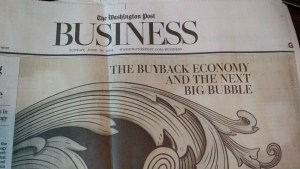Financial Crisis: “Mother of All Credit Bubbles”: Who’s Listening?

An extraordinary article by regular financial columnist Steven Pearlstein in the June 10 Washington Post warned that a surge in corporate debt has created “the mother of all credit bubbles,” and put the U.S. (and world) financial systems on the road to a new crash worse than that of 2007-8. The full-page spread featured charts showing that corporate debt, much of which is being used for stock buybacks, is increasingly risky, and that it is at record highs. Pearlstein adds that one in five companies have debt obligations exceeding their cash flow—i.e., they are zombies just waiting to die.
Much of what Pearlstein reports is not new to readers of more reliable financial reporters, such as Nomi Prins, Pam and Russ Martens, and others. This blog has reported on previous warnings by the U.S. Treasury’s Office of Financial Research, which Pearlstein mentions, and by former FDIC officials Thomas Hoenig and Sheila Bair. Pearlstein also does not stress, for example, the link between the new shaky mountain of debt, and the major banks, which are intimately connected to the so-called “non-bank lenders” involved in the current bubbles.
But Pearlstein’s summary of the current problem is sharp, and ironically, points implicitly at the solution. He writes:
“Today’s economic boom is driven not by any great burst of innovation or growth in productivity. Rather, it is driven by another round of financial engineering that converts equity into debt… Rather than using record profits, and record amounts of borrowed money, to invest in new plants and equipment, develop new products, improve service, lower prices or raise the wages and skills of their employees, they are `returning’ that money to shareholders. Corporate America, in effect, has transformed itself into one giant leveraged buyout.”
How to reverse this process? We need the policies that do the opposite: that promote growth in productivity (credit for a revolutionized infrastructure and scientific frontiers), and convert debt into equity—specifically in the way that Alexander Hamilton transformed the debt of the fledgling United States into capital for the First National Bank. After taking away the rewards and incentives for speculative borrowing (by re-imposing Glass-Steagall), we need a new National Bank for Infrastructure into which certain categories of solid debt (such as Treasury and municipal bonds) can be traded in for capital stock, which will serve as the foundation for an investment boom in the real economy.
Is anyone in Congress or the Administration listening? When the mainstream media puts out a signal like this, continued inaction on the measures before them is foolish, if not insane.

